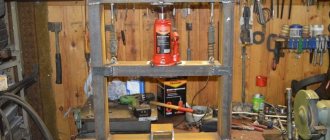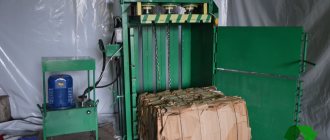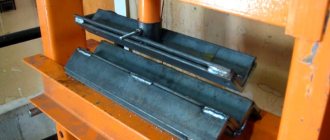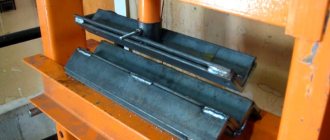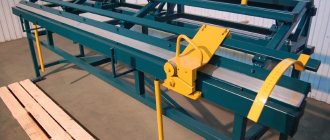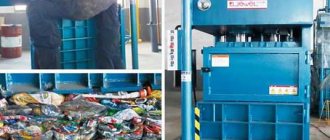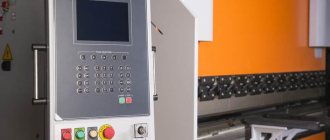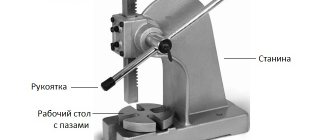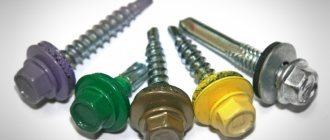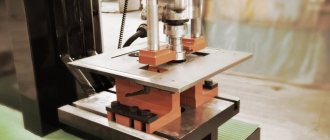For the full functioning of an automobile workshop or machine shop, it must be equipped with a manual hydraulic press. The use of such compact but effective equipment allows you to successfully and without unnecessary labor costs carry out many technological operations associated with the installation and dismantling of structural elements of various technical devices, as well as with adjusting and changing the shape of metal products.
Manual hydraulic presses are used in auto repair shops for a variety of operations.
Areas of application
Conventional hydraulic presses are not much different from portable ones intended for a car repair shop or garage, both in design and principle of operation. The main differences lie in the control systems of such devices, as well as in the range of functionality that they possess.
Using manual hydraulic presses, you can perform a certain list of technological operations, which is quite sufficient to solve the problems of repairing vehicles or any other technical devices. Depending on the size of manual pressing equipment, which directly affects its functionality, there are:
- hydraulic floor press;
- tabletop portable hydraulic press.
Devices of the first type are used for processing large parts, and a tabletop hydraulic press, characterized by compact dimensions, is used for processing small-sized products.
Pressing in the silent block using a manual hydraulic press
The most common technological operations performed using a manual hydraulic press are:
- installation and dismantling of shafts, elements of bearing units and bushings;
- stamping and calibration of metal parts;
- adjustment and change in the configuration of products made of metal.
It is not always possible to use conventional hydraulic presses for service stations or to equip a home workshop due to the rather large size of such devices. That is why the best option is to use a manual hydraulic press, which not only saves space, but often even reduces labor costs.
It should be borne in mind that the name “garage press,” which is often used in relation to manual pressing equipment, has a figurative meaning. A manual hydraulic press is a fairly universal piece of equipment that can be used not only to equip car service stations, but also in home workshops, repair shops or even garages.
Principle of operation
The operating principle of a hydraulic press is based on Pascal's law. It states that pressure is transmitted without change to any point in the liquid. The pressure in communicating cylinders of different diameters depends on the force applied and the surface area of the piston. From the equality of pressures it follows that as the area of the piston increases, the force must also increase. That is, a hydraulic press gives a gain in strength.
By applying small forces on the small cylinder, we receive greater force from the large cylinder. I hasten to assure you that the law of conservation of energy remains effective in the operation of a hydraulic press. While we gain in strength, we lose in movement. That is, the smaller piston must be moved a greater distance than the resulting piston with a larger surface area will move.
The operating principle of a hydraulic press can be compared to working using a mechanical lever. The force transmitted through the lever arm increases in proportion to the ratio of the lengths of the larger arm to the smaller one. In a hydraulic press, such a lever is liquid, and the applied force increases in proportion to the areas of the working surface of the hydraulic cylinders.
Design features and classification
In terms of their design, manual hydraulic presses (“hydro” in translation from Greek means “water,” but in such equipment the role of the working fluid is played not only by pure water, but also by mineral oil, as well as an aqueous emulsion) are very similar to jacks, for the operation of which hydraulics are used.
Operating principle of the hydraulic part of the press
The main design elements of such devices are:
- a container that contains working fluid pumped into the hydraulic cylinder;
- discharge valve and shut-off valve, ensuring safe operation of the hydraulic press;
- a lever that activates a mechanism that supplies working fluid to the chamber of a hydraulic cylinder (the result is the movement of a piston, the rod of which creates the force exerted on the executive body of the equipment).
Main parts of manual hydraulic press
The use of a lever mechanism for pumping working fluid distinguishes a hydraulic floor or tabletop manual press from stationary equipment for similar purposes. A design feature of hydraulic presses for a car service center, home workshop or garage is also that the installation of the rod in a certain position relative to the workpiece is ensured by the user. This allows the use of a hydraulic press to perform technological operations on parts located in hard-to-reach places in the structure.
In the equipment under consideration, a manual lever-type hydraulic pump is most often used as a drive.
High-performance presses can be equipped with a foot drive
The pumping of working fluid into the hydraulic cylinders of most models of stationary hydraulic presses is carried out through the use of a special compressor or hydraulic pump. Unlike manual models, a stationary hydraulic press is capable of creating greater forces, which makes it more versatile in terms of functionality. When processed on a stationary hydraulic press, the workpiece is installed on a work table, the basis of which is two powerful channels.
A thrust plate or other devices can be additionally installed between them. Many models of hydraulic garage presses and press equipment for auto repair shops are also equipped with support platforms for installing workpieces. The location of such platforms relative to the hydraulic cylinder rod can be changed, which is provided by holes drilled in the vertical racks of the equipment at different heights.
Classification of manual hydraulic presses is carried out according to a number of parameters.
- Direction of movement of the working rod. According to this parameter, there are models of manual hydraulic presses, the rod of which can move up or down. In most modern models, the rod moves downward.
- The method by which a hydraulic floor or tabletop press is driven. As mentioned above, to operate such equipment, a hand pump is used, which in some models can be replaced with an electric hydraulic pump. With such a replacement, the productivity of the pressing equipment increases.
- Possibility of equipping the rod with various attachments. The use of additional attachments, provided in the design of many modern models of manual pressing equipment, significantly expands the functionality of such devices.
- Degree of equipment mobility. Floor-standing models, like a tabletop hydraulic press, can contain special wheels in their design, which significantly increases the mobility of such devices and allows them to be moved quickly and without much labor to the location of the structure or part that needs to be processed.
Types of hydraulic presses
According to the All-Russian Classification of Fixed Assets, a hydraulic press belongs to group No. 5. This also includes all metalworking press-forging machines and hammers.
Classification by type of cylinder arrangement:
Classification by type of work:
- stamping;
- bending;
- forging;
- for flanging and beading.
Classification by bed type:
Classification by type of execution:
- With a closed frame – the frame has holes for fixing the press on the table; used for bending, straightening, pressing/pressing.
- With an open frame - for processing parts of non-standard shape and awkward design; performs similar operations.
- Universal – have a full range of functions; The hydraulic pump can be used manually.
- Press out machines – used for installation/dismantling, pressing out/pressing. Its small size allows it to be used more often in any conditions.
Modern presses cannot do without CNC. By setting the operating mode and choosing the pressure, you can forget about constant monitoring of the machine - the microcomputer will do this.
Main characteristics
When purchasing a hydraulic floor or tabletop press, you should first decide on the tasks for which it is purchased (for a car service center or for home use in the garage). The required technical and operational characteristics of the equipment will depend on the nature and complexity of such tasks.
One of the main parameters that are considered when choosing manual pressing equipment is the design. So, depending on the tasks for which the device will be used, a hydraulic floor press or a tabletop model is selected. As a rule, large service stations for which car repair is the main activity are equipped with both floor-standing and table-top models, which allows such enterprises to increase the productivity of their technological operations, as well as to offer their customers a wider range of services.
Tabletop hydraulic press with movable piston
Among the characteristics that distinguish garage or auto service hand presses are:
- hydraulic cylinder characteristics;
- parameters of the structure on which such a hydraulic cylinder is installed.
The hydraulic press parameters contain a technical passport, which should be carefully studied when choosing equipment.
The main characteristics of the hydraulic cylinder equipped with a manual press include the following parameters:
- maximum force (if you rely on the technical data sheet, the value of this parameter varies in the range of 5–20 tons);
- the distance over which the rod can move, exerting force on the workpiece;
- type of mechanism by which working fluid is pumped into a hydraulic cylinder.
Manual hydraulic jack press
When choosing a desktop model of a manual hydraulic press, it is necessary to take into account the following characteristics of the equipment, which are also contained in its technical passport:
- dimensions and weight of the device;
- type and characteristics of the working platform: its dimensions, the presence of grooves in the design for mounting additional elements, the possibility of displacement along the press frame relative to its rod;
- the presence of shock-absorbing elements in the equipment of the table press, which are necessary in order to compensate for the excess pressure created on the structure of the device.
Adjustable trapezoid plates
Parameters that require attention are also the material of manufacture and the thickness of the base plate of the manual hydraulic press on which the parts are installed during processing.
Thus, focusing on the technical characteristics contained in the passport of a manual hydraulic press, you can find a model suitable for solving specific technical problems.
Conclusion
A hydraulic press should be selected taking into account the needs of the repair/production site . Not in all cases a press with great effort is needed. An ordinary repair shop usually makes do with a 10 (tf) hydraulic press , which uses a simple lever pump.
For the production site you need to look for something more powerful and productive . The level of automation is important in production, so hydraulic presses of this class usually use an electro-hydraulic device.
Recommendations for use
In order not to encounter a situation where a manual hydraulic press requires repair after a short period of use, certain rules should be followed. First of all, it is necessary to pay attention to the correct installation of the press, focusing on the information provided in the accompanying document by the manufacturer.
Recommendations for operating a manual hydraulic press, which will avoid its frequent breakdowns and, accordingly, the need for repairs, are as follows:
- checking the working fluid level (this affects how much pressure the hydraulic cylinder can create);
- regular lubrication of moving and rubbing parts;
- checking the condition of sealing elements, which may lose their elasticity over time;
- checking the reliability of fastening the part during its processing.
Typical faults and methods for their elimination
When moving a manual hydraulic press, it is necessary to monitor the level at which the work table is located. This parameter is checked every time the pressing equipment is started.
How does a hydraulic press work?
The principle of a hydraulic press is based on the law of communicating vessels. For example, there are 2 connected containers of different sizes. By pouring the liquid there, it will be evenly distributed. If the state of rest is disturbed and the pressure in the smaller vessel is increased, then in the larger vessel the applied force will increase in proportion to the difference in size. The device obeys the rule: the gain in strength is equal to the loss in distance.
Read also: How to choose a reducer for a gas cylinder
Blaise Pascal came up with the idea of how the hydraulic press works, but called it a “machine for increasing strength.” Previously, the benefits from such a machine seemed negligible, but now engineers used Pascal's developments to make the work easier.
